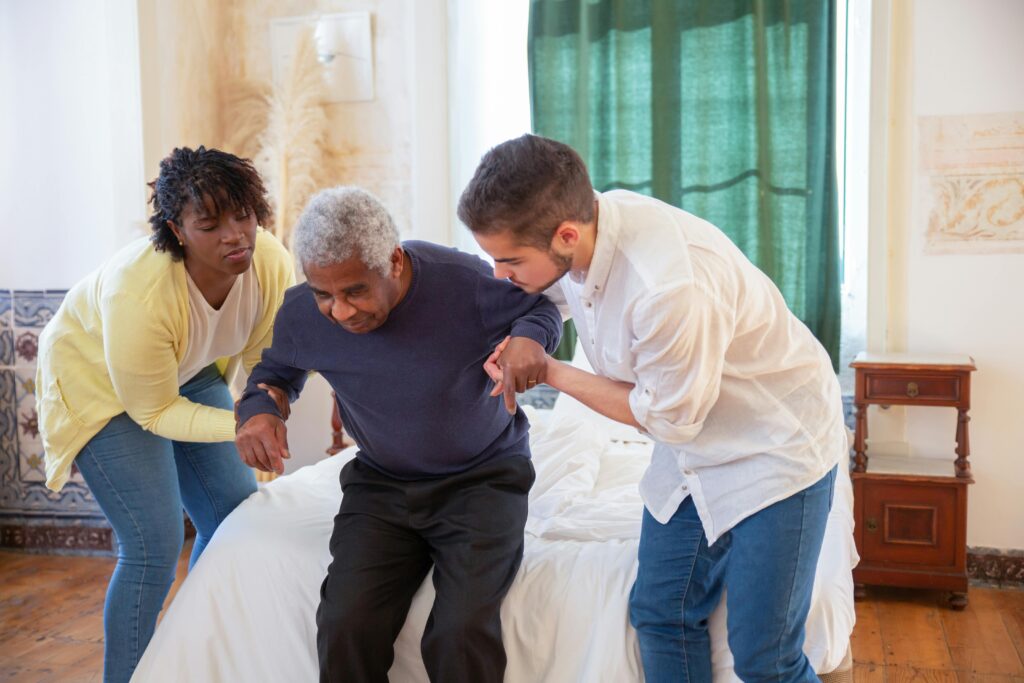Creating a safe environment for both children and seniors is crucial, especially in a home where these age groups coexist. While children explore the world around them with curiosity and enthusiasm, seniors may face challenges due to mobility issues or cognitive decline. This article serves as a comprehensive guide to childproofing and senior-proofing your home efficiently over a single weekend.
Understanding the unique needs of children and seniors is the first step toward ensuring their safety. For children, sharp corners, electrical outlets, and stairs are potential hazards. Meanwhile, seniors may struggle with slippery floors, poor lighting, and inaccessible storage. By addressing these concerns, you can create a secure living space that accommodates everyone.
This guide will walk you through a detailed approach to evaluating your home for potential risks and implementing solutions that cater to both children and seniors. Whether you’re a parent, a caregiver, or someone looking to make your home safer for visiting grandchildren or elderly relatives, these strategies will equip you with the knowledge needed to undertake this vital task.
Why Childproofing and Senior-Proofing is Important
Childproofing and senior-proofing your home is not just about preventing accidents; it’s about peace of mind. For parents, knowing that their child is safe to explore without constant supervision can alleviate anxiety. Similarly, ensuring that seniors can navigate their environment safely allows them to maintain independence and dignity in their daily lives.
Statistics show that falls are the leading cause of injury among seniors, while children are most vulnerable to incidents such as poisoning, drowning, and choking. These facts underscore the necessity of implementing preventative measures in homes where these age groups reside. By proactively addressing potential risks, you can significantly reduce the likelihood of accidents.
Moreover, a safe home environment fosters an atmosphere of inclusivity and confidence. Children can develop their motor skills and curiosity without fear, and seniors can enjoy their golden years with the comfort and security they deserve. Ultimately, a well-protected home is a testament to your commitment to the well-being of your loved ones.

Essential Tools and Supplies for Childproofing and Senior-Proofing
Embarking on a childproofing and senior-proofing project requires the right tools and supplies. Having these items on hand will streamline the process and ensure that you can address a wide range of potential hazards effectively.
Essential Supplies:
- Safety Gates: Ideal for blocking off stairways and restricted areas for children.
- Corner and Edge Bumpers: Protect children and seniors from sharp furniture edges.
- Cabinet and Drawer Locks: Prevent access to potentially dangerous contents.
- Outlet Covers: Safeguard curious children from electrical shocks.
- Non-slip Mats: Reduce the risk of falls in bathrooms and kitchens.
Tools You May Need:
- Drill and Screwdriver: For installing safety gates and grab bars.
- Measuring Tape: Ensures precise placement of safety features.
- Stud Finder: Essential for securing items to walls safely.
- Flashlight: Useful for inspecting hard-to-see areas for potential hazards.
By gathering these tools and supplies, you’ll be well-prepared to tackle the task of making your home a safer place. Remember, investing in quality products will ensure longevity and reliability, providing long-term protection for your loved ones.
Assessing Your Home: Identifying Hazardous Areas
Before diving into childproofing and senior-proofing your home, it’s crucial to conduct a thorough assessment of each area. Identifying potential hazards will allow you to prioritize actions and allocate resources effectively.
Begin by creating a checklist of rooms and high-risk areas, such as:
- Kitchens: Consider sharp objects, hot surfaces, and cleaning supplies.
- Bathrooms: Pay attention to slippery floors, hot water temperatures, and unsecured toiletries.
- Living Areas: Check for unstable furniture, reachable cords, and open staircases.
As you inspect each space, consider the perspective of both a child and a senior. For children, look for items that might pique their curiosity, such as dangling cords or small objects. For seniors, focus on obstacles that could impede movement, like loose rugs or inadequate lighting.
Once you’ve identified potential dangers, prioritize them based on severity and ease of mitigation. This will help you develop a structured plan for addressing each issue over the weekend, ensuring that your home becomes a safer haven for all residents.
Childproofing Your Home: Room-by-Room Guide
Childproofing your home requires attention to detail and a strategic approach. By focusing on each room individually, you can address specific hazards and implement solutions tailored to the needs of young children.
Living Room:
- Secure Heavy Furniture: Anchor bookcases, televisions, and cabinets to the wall to prevent tipping.
- Cover Sharp Edges: Use corner protectors on tables and shelves to cushion any falls.
- Organize Cords: Keep cords out of reach and secured to prevent tripping or strangulation.
Kitchen:
- Lock Cabinets and Drawers: Install child-proof locks on cabinets containing cleaning supplies or sharp objects.
- Use Stove Knob Covers: Prevent curious hands from turning on burners.
- Store Small Appliances Safely: Keep items like toasters and blenders away from the edge of counters.
Bathroom:
- Use Non-Slip Mats: Place mats inside and outside the bathtub or shower.
- Lock Toilets: Install toilet locks to prevent drowning risks.
- Adjust Water Heater Settings: Set the maximum temperature to 120°F to avoid scalding.
By systematically addressing these areas, you can create a safer environment for children to explore. Remember, supervision is still crucial, but these measures will significantly reduce the risk of accidents.
Senior-Proofing Your Home: Room-by-Room Guide
Senior-proofing your home involves making modifications that enhance safety and accessibility. Paying attention to common problem areas and implementing thoughtful solutions can greatly improve the quality of life for seniors.
Bedroom:
- Install Bed Rails: Provide support for getting in and out of bed.
- Clear Pathways: Ensure there is ample space to navigate around the room.
- Use Nightlights: Illuminate pathways to the bathroom to prevent nighttime falls.
Bathroom:
- Install Grab Bars: Place bars near the toilet and in the shower for added stability.
- Elevate Toilet Seats: Use raised seats to make sitting and standing easier.
- Temperature Control: Ensure hot water settings prevent scalding.
Hallways and Stairs:
- Improve Lighting: Use bright bulbs to light hallways and staircases.
- Secure Handrails: Check that handrails are sturdy and extend the full length of stairs.
- Remove Obstacles: Keep hallways free of clutter and trip hazards.
By addressing these key areas, you can create a safer and more comfortable environment for seniors. These changes not only prevent accidents but also promote independence and confidence in their daily activities.
Quick Fixes: Simple Changes with Big Impact
Sometimes, small adjustments can have a significant impact on the safety and accessibility of your home. These quick fixes can be implemented easily and often at little cost, making them ideal for a weekend project.
Simple but Effective Changes:
- Install Door Alarms: Alert you when a door is opened, useful for both child and senior safety.
- Rearrange Furniture: Create clear paths and eliminate trip hazards.
- Use Color Contrasts: Help seniors with vision impairments by using contrasting colors on stair edges.
Additional Considerations:
- Regularly Test Smoke and Carbon Monoxide Detectors: Ensure they are functional and batteries are changed regularly.
- Organize Emergency Contact Information: Keep phone numbers and medical information accessible.
- Declutter Regularly: Reduce clutter to minimize the risk of falls and accidents.
These simple changes can drastically improve safety and are easy to implement. By dedicating a few hours to these tasks, you can enhance the overall security of your home environment for everyone.
Weekend Project Plan: Step-by-Step Approach
To efficiently childproof and senior-proof your home in a weekend, it’s essential to have a clear plan of action. Dividing tasks into manageable steps will help you stay organized and ensure that nothing is overlooked.
Step-by-Step Plan:
- Day 1 Morning: Assess each room for hazards using your checklist.
- Day 1 Afternoon: Gather tools and supplies, focusing on priority areas.
- Day 1 Evening: Start with quick fixes that offer immediate improvement.
- Day 2 Morning: Install safety equipment, such as gates, locks, and bumpers.
- Day 2 Afternoon: Focus on room-by-room improvements, addressing both child and senior needs.
- Day 2 Evening: Review completed tasks, ensuring all safety measures are securely installed.
By following this plan, you can make significant progress in a short time. Remember to involve family members or friends to assist with tasks, making the process more efficient and enjoyable.
Safety Tips for Ongoing Maintenance
After your initial childproofing and senior-proofing efforts, ongoing maintenance is crucial to ensure that safety measures remain effective. Regular checks and updates will help prevent accidents and adapt to changing needs.
Maintenance Tips:
- Regularly Inspect Safety Features: Check that all locks, gates, and bumpers are in good condition and functioning properly.
- Adapt to Growth and Change: As children grow or seniors’ needs evolve, adjust safety measures accordingly.
- Stay Informed: Keep up with new safety products and recommendations from trusted sources.
Additionally, encourage open communication with family members about any concerns or suggestions regarding home safety. This collaborative approach will help maintain a secure environment for everyone.
Professional Help: When to Hire Experts
While many childproofing and senior-proofing tasks can be done independently, some situations may require professional assistance. Knowing when to hire experts can save time and ensure that complex modifications are done correctly.
When to Consider Professional Help:
- Structural Changes: Installing ramps, widening doorways, or significant bathroom modifications.
- Electrical Work: Adding extra lighting or electrical outlets for accessibility and safety.
- Expert Assessments: Hiring a professional to conduct a thorough home safety evaluation.
Engaging professionals can provide peace of mind, knowing that your home is equipped with the best possible safety solutions. They can offer expert advice and tailor recommendations to suit specific needs, enhancing the overall effectiveness of your safety efforts.

Conclusion: Ensuring a Safe Home for All Ages
Creating a safe and welcoming environment for both children and seniors is a rewarding endeavor that benefits the entire family. By dedicating a single weekend to childproof and senior-proof your home, you invest in the well-being and security of your loved ones.
Remember, safety is an ongoing commitment. Regular maintenance, open communication, and adaptability are key to ensuring that your home remains a safe haven for all ages. Whether you’re a parent, caregiver, or simply a concerned family member, your efforts to enhance home safety will have a lasting positive impact.
Are you ready to take the first step toward a safer home? Start your weekend project now and experience the peace of mind that comes with knowing your home is secure for everyone. And if you find the task overwhelming, don’t hesitate to reach out to professionals for guidance and support. Together, we can create a world where every home is a safe haven.
FAQ
1) Why is childproofing and senior-proofing your home important?
Childproofing and senior-proofing prevent accidents and provide peace of mind. It ensures children can explore safely and seniors can maintain independence, reducing anxiety for caregivers.
2) What are essential supplies for childproofing and senior-proofing?
Essential supplies include safety gates, corner bumpers, cabinet locks, outlet covers, and non-slip mats. These items help prevent common hazards in homes with children and seniors.
3) How should I assess my home for potential hazards?
Create a checklist for each room, focusing on kitchens, bathrooms, and living areas. Identify sharp objects, slippery floors, unstable furniture, and poor lighting to prioritize actions.
4) What are some quick fixes for improving home safety?
Quick fixes include installing door alarms, rearranging furniture, using color contrasts on stairs, testing smoke detectors, and decluttering regularly to reduce fall risks.